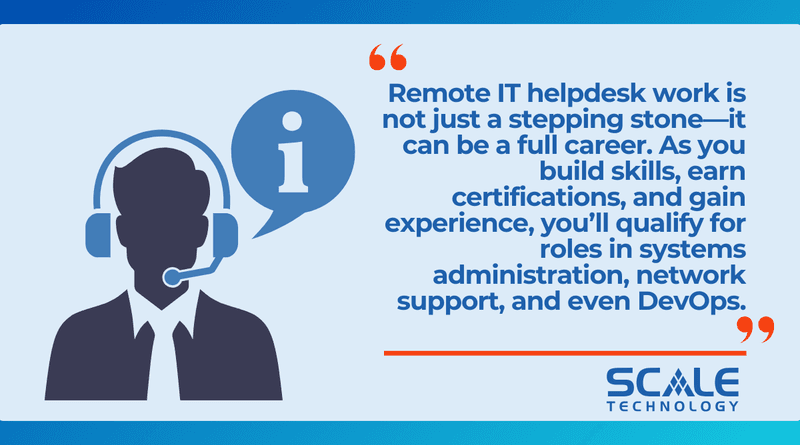Thinking about working in tech but want to skip the office routine? A remote IT helpdesk job could be a fit. You help people fix tech problems—all from home. It’s consistent work with opportunities to move up. If you're good at solving issues and staying organized, this role may suit you.
Key Takeaways:
- Remote IT helpdesk technicians solve tech issues by phone, email, or chat using tools like Bomgar and TeamViewer
- Common tasks: password resets, printer errors, software installs, network fixes, and ticket tracking
- Entry-level roles (Tier 1 Support, Help Desk Analyst) usually require no experience or degree—just problem-solving and communication skills
- Helpful certifications: Google IT Support, CompTIA A+, HDI, ITIL Foundation
- Top tools: Bomgar, VNC, RemotePC, Remote Desktop, Zendesk, Jira
- Industries hiring: Healthcare, Education, SaaS, and BPO
- Pay ranges from $18–$45/hour; full-time roles may include benefits like 401(k) and health insurance
- Popular job boards: Indeed (more listings), ZipRecruiter (clearer pay info)
- Career path: Start at Tier 1 → move to Tier 2 → System Admin → DevOps or Team Lead (with training and experience)

Remote IT Helpdesk Careers: How to Start, Succeed, and Grow in Tech Support
The demand for remote IT helpdesk professionals continues to grow, offering flexible and rewarding opportunities for those ready to support users and solve problems from anywhere. As businesses increasingly rely on digital tools, the need for quick and efficient technical support rises, making remote IT helpdesk roles essential. These positions blend tech knowledge with communication skills, providing a solid entry point into the IT world.
At Scale Technology, our remote IT support solutions play a crucial role in keeping businesses across industries secure, productive, and focused. If you're interested in a fast-paced, high-impact environment, a remote IT helpdesk position might be perfect for you.
Remote Roles Solve Problems from Anywhere
A remote IT helpdesk technician assists users by addressing tech issues via phone, chat, or email. These team members troubleshoot problems such as login errors, software crashes, printer issues, or network interruptions. They use remote tools to view screens, run diagnostics, and apply quick fixes—often without ever needing to be physically present.
In a typical day, you might reset passwords, guide users through software installations, or resolve screen-sharing problems. You’ll also log tickets and escalate more complex issues to senior team members. Because problems vary, each shift offers new experiences, and staying calm under pressure is essential.
Technicians often rely on tools like Bomgar, VNC, TeamViewer, and Remote Desktop. These allow them to control a user’s device remotely and resolve issues quickly. They also use ticketing systems like Zendesk or Jira to log and track their work.
Entry-Level Paths Make Getting Started in Remote IT Helpdesk Easy
You don’t need years of experience to get started in this field. Entry-level roles like Help Desk Analyst or Tier 1 Technician are designed to train you on the job. These positions focus on basic tasks like password resets, user support, and software updates.
Certifications such as CompTIA A+ and Google’s IT Support Certificate can help you stand out. These programs teach you how to troubleshoot hardware, manage network connections, and interact with users effectively. Many are available online, making it easier to learn while working or studying.
For additional training resources, tools like CareerOneStop offer free or low-cost programs to build skills in tech support.
The Right Tools Make Remote IT Helpdesk Work Possible
Remote IT helpdesk professionals must learn to use a core set of tools. These include:
- Remote access software like RemotePC, Bomgar, or TeamViewer
- Communication apps like Microsoft Teams or Slack
- Ticketing platforms such as Freshdesk or ServiceNow
- Diagnostic tools for monitoring systems and identifying problems
Most jobs also expect a basic home setup: fast internet, a quiet space, a quality headset, and ideally dual monitors. These tools help you multitask and communicate clearly with users.
Although a degree isn’t required, certifications like ITIL Foundation or HDI Desktop Support can help show employers that you’re serious and capable.
Remote IT Helpdesk Technicians Need Both Tech and People Skills
While technical knowledge is key, soft skills are just as important in remote IT helpdesk roles. You’ll need to explain technical issues in simple terms and stay calm while helping users who may be frustrated or confused.
Listening carefully, asking the right questions, and offering clear instructions go a long way. Employers look for candidates who are empathetic, responsive, and detail-oriented.
Track your progress by keeping notes, reviewing tickets, and reflecting on how each situation was handled. Doing so not only improves your service but also prepares you for more advanced roles in the future.
Growth Opportunities Are Built Into Remote IT Helpdesk Careers
Starting in a Tier 1 helpdesk role gives you a strong foundation in IT. Over time, you can move into Tier 2 support, then specialize in systems administration, DevOps, or network engineering.
Here’s a common career path:
Tier 1 Helpdesk → Tier 2 Support → Systems Admin → DevOps or IT Lead
Each step builds on your previous experience. As you gain knowledge and demonstrate your ability to solve more complex problems, new doors open. To accelerate your progress, earn certifications like CompTIA Network+, Linux+, or Microsoft AZ-104. These credentials show that you’re ready to take on higher-level tasks.
Remote IT Helpdesk Jobs Are Available Across Every Industry
Many industries rely on remote IT helpdesk support. Healthcare providers, for example, use EPIC and other electronic health records (EHR) systems that require fast and accurate tech support. Education institutions need help managing devices, student portals, and Wi-Fi access. Software companies need agents to support their platforms. Even nonprofits and small businesses rely on remote IT helpdesk professionals to stay up and running.
Because every industry uses technology differently, technicians often gain specialized knowledge over time. This makes them more valuable and opens the door to higher-paying roles.
Salary Expectations for Remote IT Helpdesk Technicians Vary by Skill
Entry-level remote IT helpdesk roles typically pay between $18 and $25 per hour. More advanced positions—especially those requiring systems knowledge or industry certifications—can pay as much as $40 or even $45 per hour.
Full-time jobs often come with benefits like health insurance, paid time off, and 401(k) matching. Contract roles may offer higher hourly rates but lack long-term perks. Some companies offer flexible hours, tuition assistance, or options to work night shifts.
With continued learning and strong performance, it’s possible to grow your income steadily while gaining new opportunities.
Job Boards Make Finding Remote IT Helpdesk Roles Easy
If you're looking for remote IT helpdesk jobs, start with Indeed and ZipRecruiter. Both platforms allow you to filter by location, pay, or shift type. You can search using terms like “remote support,” “Tier 1 IT,” or “helpdesk technician.”
Turn on alerts for new roles and save listings that interest you. Complete your profile with your skills, certifications, and past experience. Mention tools like Remote Desktop, VPN, or Zendesk in your resume to match job descriptions more closely.
Your Resume and Interview Should Reflect Remote Readiness
A strong resume makes all the difference. Focus on clarity, keywords, and results. Mention tools you’ve used (like VNC or Bomgar), note how many tickets you resolved daily, and highlight your communication skills.
Use bullet points and keep your formatting simple. If you’ve worked remotely before—even in a different field—mention it. Employers want to know you can stay focused and solve problems from home.
During interviews, be ready to walk through technical scenarios. Also, explain how you would handle stressful situations or frustrated users. Keep your answers calm, clear, and structured.
Remote Troubleshooting Tools Are at the Core of the Job
Remote IT helpdesk professionals rely heavily on software that lets them control or view a user’s computer. Tools like:
- Bomgar (BeyondTrust) – secure, enterprise-grade access
- VNC – lightweight and widely used
- RemotePC – cloud-based and user-friendly
These tools allow you to diagnose problems, install updates, or reset configurations without being physically present. You’ll also use platforms like Okta or Microsoft Password Reset to manage user credentials securely.
Every ticket you handle should be logged and tracked. This helps your team stay organized and ensures users receive consistent support.
The Most Popular Roles in Remote IT Helpdesk Today
Several roles dominate this space:
- Tier 1 Helpdesk Technician: handles basic tasks like password resets and email troubleshooting
- EHR Support Specialists: assist healthcare workers using platforms like EPIC
- Client Support Agents: manage customer inquiries and solve problems via live chat or email
- Remote Desktop Technicians: fix technical problems directly through screen control
Some roles are part-time, while others are full-time with benefits. Students, career changers, and tech enthusiasts alike can find opportunities that fit their schedule and skills.
Industries Hiring Remote IT Helpdesk Staff Are Growing Fast
Industries that highly depend on remote IT helpdesk support include:
- Healthcare: for EHR and compliance-related support
- Education: for device help, portal access, and student support
- Software: for SaaS products and platform troubleshooting
- Business Process Outsourcing (BPO): high-volume support across various tools
These sectors need reliable tech support to keep operations running. And as more companies adopt remote work models, the need for distributed IT support continues to grow.
You Can Build a Long-Term Career Starting in Remote IT Helpdesk
Remote IT helpdesk work is not just a stepping stone—it can be a full career. As you build skills, earn certifications, and gain experience, you’ll qualify for roles in systems administration, network support, and even DevOps.
You’ll also learn valuable soft skills—like patience, communication, and time management—that are useful in any job. Some professionals even move into management, overseeing helpdesk teams or entire IT departments.
To grow your career:
- Start with Tier 1 tasks
- Learn tools like Active Directory or scripting
- Earn certifications like Microsoft AZ-104 or CompTIA Security+
- Keep learning and take on new challenges
- Document your wins and build a strong portfolio
Over time, these steps lead to more responsibility, higher pay, and greater job flexibility.
Ready To Take the First Step Toward Your Career in Tech?
Explore Opportunities With Scale Technology
If you’re passionate about solving problems and love working with technology, Scale Technology wants to hear from you. We offer roles that let you grow your skills across industries while supporting businesses that rely on strong IT foundations. Whether you're just starting out or want to take the next step in your tech career, our team is ready to connect.
Reach out today and start building a future in remote IT support.
The field of remote IT helpdesk work is full of opportunity. Whether you're aiming for flexibility, security, or future growth, this path offers all three. With the right tools, training, and support, you can build a meaningful career—without ever leaving home.

